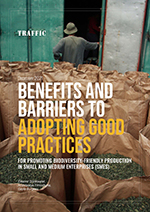What do gummy bears and biodiversity have in common?

“Carnaúba wax?!”. Not many of us have heard about this natural wax extracted from the Copernicia cerifera palm tree – and yet we encounter it every day.
“Carnaúba wax?!”. Not many of us have heard about this natural wax extracted from the Copernicia cerifera palm tree – and yet we encounter it every day, as a coating agent on gummy bears and chocolate, as a car polish, as a separating agent in bread and in cosmetics such as lipsticks and mascara.
Carnaúba wax production is only possible in northeast Brazil due to climatic conditions,yet the industry is facing significant challenges. The palm tree secretes a layer of wax on to its leaves to protect them from the dry climate. This wax is a vital source of income for thousands of families. In an arduous process, agricultural workers harvest the leaves and extract the wax during the six-month dry period. Long sticks are used to collect the leaves, which are then dried in the sun, before thewax is extracted, either mechanically or by hand.
If we are to preserve this species of palm tree in its natural environment, agricultural and working conditions mustchange.. Working conditions should become more humane and attractive for the younger generation and the agricultural workers must earn enough to feed their families. Technical innovations and investments in biodiversity protection are also sorely needed, because if the palms lose their value for the local population, they will eventually be eradicated by the invasive non-indigenous Indian rubber vine, which is spreading rapidly throughout the areas where the palm trees grow.
 The carnaúba palm is an important part of the Caatinga ecosystem, a dry savannah. This area of Brazil is extremely affected by deforestation and is one of the most impoverished regions of the country.The Carnaúba palm trees are therefore avital part of the ecosystem in the “Caatinga” where they help to preserve the soil and store water. They also serve as a habitat and food source for other species, ensuring their survival.
The carnaúba palm is an important part of the Caatinga ecosystem, a dry savannah. This area of Brazil is extremely affected by deforestation and is one of the most impoverished regions of the country.The Carnaúba palm trees are therefore avital part of the ecosystem in the “Caatinga” where they help to preserve the soil and store water. They also serve as a habitat and food source for other species, ensuring their survival.
So how can the right instruments help to meet the challenges of maintaining this biodiversity value chain and increase investment in biodiversity conservation? The IKI project – Private Business Action for Biodiversity – is currently addressing the issues faced by the Carnaúba in Brazil. The project is also carrying out other case studies for biodiversity-friendly production and marketing in India and Mexico.
Initiative for Responsible Carnaúba
To address this, the Union for Ethical BioTrade (UEBT) and several enterprises founded the “Initiative for Responsible Carnaúba: Sustainable livelihoods, Carnaúba production and preservation of biodiversity in northeast Brazil”. Well-known international companies are among a total of almost 20 participating organisations, which are developing new approaches to tackle the many social and environmental challenges involved in the production of the wax, including traceability.
Three of the most important Brazilian Carnaúba wax companies have already joined the initiative and are implementing the UEBT’s social and environmental standards as well as more transparent purchasing processes. These companies inform agricultural workers about their rights, organise training and distribute safety equipment. Their agenda also includes the development of action plans to protect biodiversity.
O ne company is already actively collecting fruits and seeds from the region to restore at least 25 native species in the forests and research is also being carried out to combat the non-native vines that are threatening the Carnaúba palm. The entrepreneur Lara Pontes aptly summarises the situation: “Carnaúba was and is a gift in our region here in northeast Brazil, and we must take care of it. For generations, people have earned a living from this palm tree, and our commitment to respectful working conditions, fair and secure wages and the protection of biodiversity is paving the way to a better future.”
ne company is already actively collecting fruits and seeds from the region to restore at least 25 native species in the forests and research is also being carried out to combat the non-native vines that are threatening the Carnaúba palm. The entrepreneur Lara Pontes aptly summarises the situation: “Carnaúba was and is a gift in our region here in northeast Brazil, and we must take care of it. For generations, people have earned a living from this palm tree, and our commitment to respectful working conditions, fair and secure wages and the protection of biodiversity is paving the way to a better future.”
Good Practices Manual
To establish these good practices throughout the sector, the IKI project – with the help of public consultation and the non-governmental organisation Associação Caatingahas – has compiled a Good Practices Manual, which was presented at a Carnaúba seminar in November 2019. It can be downloaded as a PDF in Englisch and Portuguese. Learning videos are also being developed. These videos will be used to reach the field workers via Whatsapp and YouTube.
The link has been copied to the clipboard
Contact
IKI Office
Zukunft – Umwelt – Gesellschaft (ZUG) gGmbH
Stresemannstraße 69-71
10963 Berlin










